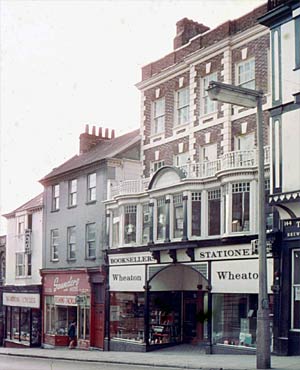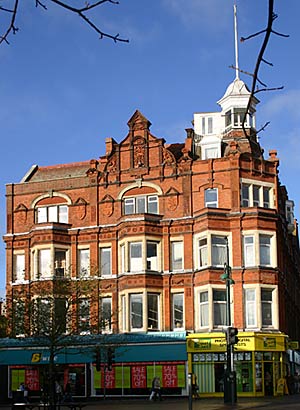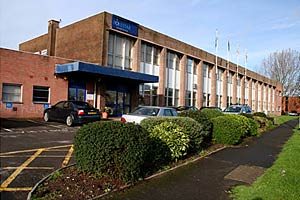
- Home
- Memories
- Scrapbook ▽
- Topics ▽
- People ▽
- Events
- Photos
- Site Map
- Timeline
Page updated 23 June 2009
Return to Service Industry
A. Wheaton and Company is one of the oldest, still trading companies in Exeter. It can be traced back to 1780, when James Penny opened a bookshop and printer in Southgate Street. In 1792 he moved to North Street and then to 185 Fore Street. The business carried on in the early 19th century through various changes until it was advertised for sale on the 30th April 1835 and William Wheaton purchased the business on 2nd July in the same year.
An 1844 Old Moore's Almanac has Wheaton's adverts, not only for school books, but surprisingly, also patent medicines. Antibilious pills, Pennyroyal Fennole Pills, and Magic Pills for curing gout and more could be found next to copies of books on Spellings, Grammars, Exercises, Psalters, Tutors Assistants and Catechisms.
William died in 1846 and the business was taken over by his widow, and soon after, his son, Alfred Wheaton.
In 1851, Alfred also died, and the business passed to his sisters, Mary and Anne. At this time they had premises at 185 Fore Street and 19 High Street. In 1880, 186 Fore Street was purchased and joined to their premises next door.
Disaster struck when the Fore Street shop along with several surrounding premises was destroyed by what is known as 'The Great Exeter Fire' in 1882. In fact there were two fires, one on 18th January and one on 27th July. An Exeter newspaper report said that ' very little is left but the shell'. When the re-building work was complete, most of Paternoster House, as it was named, after the publishing district in London, became the home of the furniture store Wm. Brock and Co, and the corner shop was occupied by Wheatons.
The building was the first in Exeter to have a lift and is now informally known as Cornish's, a later tenant that closed in the late 1980's. The corner shop houses Snappy Snaps and most of the rest of the building B-Wise.
Wheatons expanded and 223 High Street was leased from 1886 until 1927, when Boots the Chemist took the premises over.
Further expansion occurred in 1901 when they acquired S Lee and Company, a small printing works at 1 Preston Street. The works at this time was producing labels, magazines and general trade printing. Soon after, the premises of the Western Times Company, were vacated at 143 Fore Street, and the Wheatons printing works soon moved in to the building. These premises were built in 1714 by the merchant, Sir Thomas Bury in the Queen Anne style. In 1733, another merchant, Sir John Duntze purchased the building, and it became his family home until 1788. It was in the 19th century that the Western Times moved in - Charles Dickens, a friend of the editor, Thomas Latimer, is reputed to have stayed in the house, during 1839.
Trade slowly expanded, and then in 1906, the business was incorporated as a limited company. The first venture into educational publishing and printing was in 1910 when they produced a set of observation drawing cards. The firm prospered, guided by Mary and Anne Wheaton's nephew, Alfred who had started working for the business at a very young age. He retired at the age of 76, after a long working life in 1928. Like many successful Victorian businessman, he was active in politics as a Liberal and a keen congregationalist.
In 1926, a teenage Arthur John Wheaton, who would become chairman of the company, was like many young men, a motorcycle enthusiast. With the backing of the family, and using a workshop in the print works off Friernhay Street he started to build his own motorcycles.Within a year he founded AJW Motorcycles, which would become a well respected manufacturer of quality, high performance motorcycles through the 1930s.
In 1927, Wheaton's moved to 231-232 High Street, opposite St Stephen's Church. The May 1942 air raid saw these premises totally destroyed, along with all the others in this part of the High Street. The bookshop was moved to a cellar in Gandy Street and then to 198 High Street, between the Guildhall and North Street, in the late 1940's.
After the war the printing works stretched from Fore Street to Bartholomew Street and contained both printing and bookbinding on its 65,000 sq ft floor. The printing works was a specialist in producing educational text books for both the UK market and export around the world. They would obtain the rights for text books produced for the American market, and have them Anglicised. The premises were proving to be inadequate and in September 1965 it was announced that the works was to move to a newly built site at Hennock Road, Marsh Barton. The Wheaton family were still running the business, Alfred's son Fred had retired in 1961, leaving the business in the capable hands of other family members, including the motor cycle enthusiast, Arthur John as chairman.
In 1966, Wheatons were taken over by Robert Maxwell's, Pergamon Press, one of the largest publishers in the country. John Wheaton remained as chairman of the company. At this time they employed 280 workers in the Fore Street works, and two years later, the new printing works was opened by Robert Maxwell on 24th May 1968. Situated on six acres of land at Marsh Barton, it cost at the time, £350,000, with a further £1,000,000 spent on new printing machinery. Pergamon were to take over the educational publishing and Wheatons were to be the groups main printer. It took until November 1973 for the Fore Street premises to be finally vacated and the Hennock Road site to be fully functional.
Changing economic conditions led to the bookshop at 198 High Street being closed in 1967, with the loss of 23 jobs. Some of this business was transferred to the Fore Street premises. At the time, the privately owned company blamed the introduction of the new Selective Employment Tax on the closure, but Britain was going through difficult times in the 60's and 70's and competition from other national high street booksellers must have caused a decline in trade.
By 1974, the print works employed 400 people, but Robert Maxwell reported that he needed another 200 to achieve full production - the problem cited at the time was that workers moving to the area could not obtain housing. At this time, the managing director of Wheatons was Anthony Wheaton, the great Grandson of the founder Alfred. The 1980's were not kind to Wheatons and they had to compete against fierce competition. A result of this was some of the unusual publications that were produced by the company. They printed 90,000 copies of Shirley Conran's bestsellers, Lace and Savage and strangely, the speeches of Deng Xiaoping in 1984.
In March 1980, the last vestiges of Wheaton's retail outlet in Fore Street was finally closed after 150 years of trading and the whole of Wheatons was now based at Marsh Barton.
In 1991, 31 lost their jobs when Wheaton Publishers Ltd closed. The company avoided the problems faced by other Pergamon subsidiaries when Maxwell mysteriously died by drowning off the Canary Islands in November 1991, and left his empire in financial straights. Wheatons is now known as Polestar Wheatons and they remain the country's largest educational and scientific printers.
Sources - Express and Echo cuttings and documents held by Devon Library Information Services, Lost Exeter by Todd Gray. © 2005 David Cornforth - not to be reproduced without permission
 143 Fore Street in the
1960's. Photo courtesy of Alan H Mazonovicz.
143 Fore Street in the
1960's. Photo courtesy of Alan H Mazonovicz.
 Snappy Snap in the
premises most remember as Cornish and Co, in Paternoster House. It was
Wheatons until 1905.
Snappy Snap in the
premises most remember as Cornish and Co, in Paternoster House. It was
Wheatons until 1905.
 Wheatons had a shop at
223 High Street. It became the site of Boots the Chemist, then C &
A and now Tesco Metro and JJB Sports. Photo courtesy of Terry
Kent
Wheatons had a shop at
223 High Street. It became the site of Boots the Chemist, then C &
A and now Tesco Metro and JJB Sports. Photo courtesy of Terry
Kent Polestar on Marsh Barton Trading Estate.
Polestar on Marsh Barton Trading Estate.
If you have a photo relating to Wheatons the Printers, and would like to share it, please contact me on the email address at the foot of the page.
│ Top of Page │